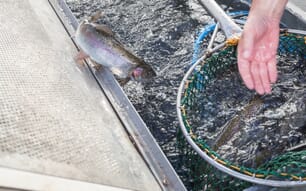Viral hemorrhagic septicemia virus (VHSV) is the causative agent of a highly contagious disease of both saltwater and freshwater fish in the northern hemisphere. VHSV is a novirhabdovirus (Rhabdoviridae) (Tordo et al. 2005) that is listed as a notifiable pathogen by the World Organization for Animal Health (OIE).
The severity of infection and its outcome varies by fish species, age, immune status, and prevailing environmental conditions. Dependent on the species of fish, infection may result in substantial mortality (Smail & Snow 2011, Kim & Faisal 2010a,b,c, Groocock et al. 2012).
VHSV can become endemic in fish populations, with some individual fish serving as carriers of the virus and periodically shedding the virus, which causes repeat episodes of disease in naïve fish populations (Hershberger et al. 2010, Kim & Faisal 2012). Since its emergence in the Laurentian Great Lakes of North America, the novel sublineage of VHSV genotype IV has caused several large-scale die-offs of wild fish and spread into the 5 Great Lakes, a number of inland lakes, and several streams (Elsayed et al. 2006, Gagné et al. 2007, Groocock et al. 2007, Lumsden et al. 2007, Cornwell et al. 2011, 2012).
VHSV is now endemic in the Great Lakes and represents a serious risk to farmed fish populations within the Great Lakes watershed as well as a risk for dissemination of the virus to other watersheds within or outside the USA by movement of fish (reviewed by Faisal et al. 2012).
The current gold standard for detection of VHSV in either clinical or non-clinical fish is virus isolation in cell culture followed by virus identification (AFS-FHS 2010, OIE 2012). Virus isolation in cell culture is a long and labor-intensive process.
Multiple real-time RTPCR (rRT-PCR) assays with rapid turnaround time have been developed and suggested for use in VHSV surveillance efforts or for routine diagnosis of viral hemorrhagic septicemia (VHS) (Chico et al. 2006, Liu et al. 2008, Matejusova et al. 2008, 2010, Cutrín et al. 2009, Hope et al. 2010, Garver et al. 2011, Jonstrup et al. 2013, Pierce et al. 2013a,b).
However, in order to consider utilization of any VHSV rRT-PCR assay in surveillance or diagnostic activities where testing is conducted in multiple laboratories and where the results from multiple laboratories may be used to support declarations of freedom from the pathogen, the testing protocol must be standardized, robust, and performance estimates well characterized.
The definition of what constitutes a standardized testing protocol varies. For rRT-PCR assays, the OIE Aquatic Diagnostic Manual frequently lists primers, probe, and cycling conditions but lacks many of the details that can influence a test’s outcome.
Quality controls (such as extraction and amplification controls and acceptable cycle threshold [Ct] value ranges for positive extraction and amplification controls) and interpretation criteria need to be defined in the standardized testing protocol.
To this end, the USDAAPHIS coordinated efforts of 8 laboratories to compare the analytical performance of 4 rRT-PCR protocols that utilized 3 previously published primers and probe sets (Hope et al. 2010, Garver et al. 2011, Phelps et al. 2012, Jonstrup et al. 2013) following OIE validation guidelines.
In addition, the purpose of this comparison is exclusively for detection (an unequivocal positive or negative test result) of VHSV for diagnosis or surveillance, although the assays could be used for relative quantitation purposes.
The participating laboratories received and followed a standard operating protocol for extraction and for each of the rRT-PCR assays.
This paper reports the criteria used for the comparison of assay performance across participating laboratories as well as the results.
Performance measures specifically investigated included limit of detection (LOD), defined as the smallest amount of analyte in which 95% of the samples are classified as positive, analytical specificity, estimates of assay efficiency across genotype representatives, within- and between- plate variation within a laboratory, variation between laboratories using the same platform, between platforms, and between software versions.
In addition, both the LOD and the efficiency estimates can be used as indicators of laboratory/ technician sensitivity differences related to sample handling (serial dilutions of virus stocks) within a testing laboratory.
Performance measures were used collectively to select assays for further evaluation and to make recommendations on the suitability of each of these assays for surveillance and diagnostic purposes.
October 2014




